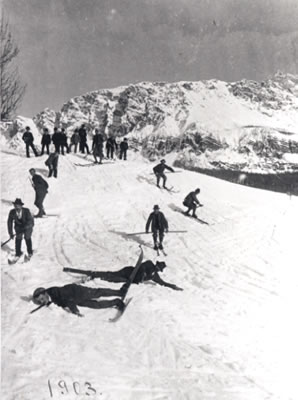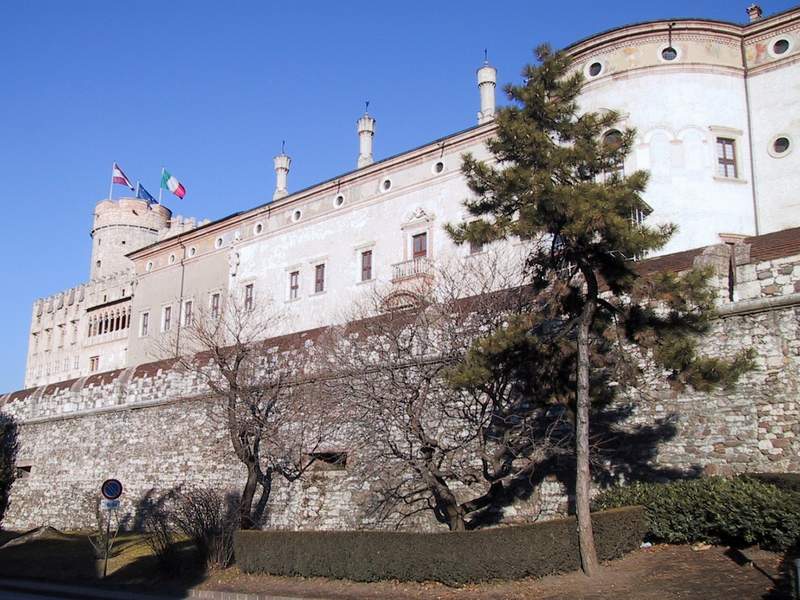|
White Friday (1916)
White Friday occurred during the Italian Front of World War I, when an avalanche struck Austro-Hungarian barracks on Mount Marmolada, killing 270 soldiers. Other avalanches the same day struck Italian and other Austro-Hungarian positions, killing hundreds. According to some reports both sides deliberately fired shells into the weakened snowpacks in an attempt to bury the other side. An accurate estimation of the number of casualties from the White Friday avalanches is not available. Historical documents suggest at least 2,000 victims among the soldiers and a few dozens among civilians. The date 13 December, marked Saint Lucia, a commemorative religious holiday practiced by the majority of Italian Catholics. Though the occurrence of avalanches in the Dolomites Mountains took place on a Wednesday in 1916, the term "White Friday" was used to coin the disastrous day. Gran Poz summit Avalanches The Austro-Hungarian '' Kaiserschützen'' military barracks was built on the Gran Po ... [...More Info...] [...Related Items...] OR: [Wikipedia] [Google] [Baidu] |
Dolomites
The Dolomites ( it, Dolomiti ; Ladin: ''Dolomites''; german: Dolomiten ; vec, Dołomiti : fur, Dolomitis), also known as the Dolomite Mountains, Dolomite Alps or Dolomitic Alps, are a mountain range located in northeastern Italy. They form part of the Southern Limestone Alps and extend from the River Adige in the west to the Piave Valley (Pieve di Cadore) in the east. The northern and southern borders are defined by the Puster Valley and the Sugana Valley (Italian: ''Valsugana''). The Dolomites are located in the regions of Veneto, Trentino-Alto Adige/Südtirol and Friuli Venezia Giulia, covering an area shared between the provinces of Belluno, Vicenza, Verona, Trentino, South Tyrol, Udine and Pordenone. Other mountain groups of similar geological structure are spread along the River Piave to the east – ''Dolomiti d'Oltrepiave''; and far away over the Adige River to the west – ''Dolomiti di Brenta'' (Western Dolomites). A smaller group is called ''Piccole Dolomiti'' (Li ... [...More Info...] [...Related Items...] OR: [Wikipedia] [Google] [Baidu] |
List Of Avalanches ...
This is an incomplete list of notable avalanches. See also *Avalanche * List of natural disasters by death toll References External links {{DEFAULTSORT:List Of Avalanches * Avalanches in the United States Death in the United Kingdom Death in the United States Avalanches Avalanche An avalanche is a rapid flow of snow down a slope, such as a hill or mountain. Avalanches can be set off spontaneously, by such factors as increased precipitation or snowpack weakening, or by external means such as humans, animals, and earth ... [...More Info...] [...Related Items...] OR: [Wikipedia] [Google] [Baidu] |
History Of Veneto
History (derived ) is the systematic study and the documentation of the human activity. The time period of event before the invention of writing systems is considered prehistory. "History" is an umbrella term comprising past events as well as the memory, discovery, collection, organization, presentation, and interpretation of these events. Historians seek knowledge of the past using historical sources such as written documents, oral accounts, art and material artifacts, and ecological markers. History is not complete and still has debatable mysteries. History is also an academic discipline which uses narrative to describe, examine, question, and analyze past events, and investigate their patterns of cause and effect. Historians often debate which narrative best explains an event, as well as the significance of different causes and effects. Historians also debate the nature of history as an end in itself, as well as its usefulness to give perspective on the problems of the p ... [...More Info...] [...Related Items...] OR: [Wikipedia] [Google] [Baidu] |
History Of Trentino
The History of Trentino begins in the mid- Stone Age and continues to the present day when Trentino is part of the Italian Republic. Ancient history During the Stone age the valleys of what is now Trentino were already inhabited by humans, the main settlements being in the valley of the Adige River, thanks to its milder climate. Research suggests that the first settlers (probably hunters) came from the Padana Plain and the Venetian Prealps, after the first glaciers began melting at the end of the Pleistocene glaciations. Findings (in particular, burials) from the Mesolithic period have been found in several parts of the province. These include the ''comuni'' of Zambana and Mezzocorona. A large area of a hunting-based settlement from the Neolithic period has been found near the lakes of Colbricòn, not far from the Rolle Pass. Around 500 BC, the Raetians appeared in the Trentine area, coming from the Central and Eastern Alps area. They settled in several valleys and brought ... [...More Info...] [...Related Items...] OR: [Wikipedia] [Google] [Baidu] |
Austria-Hungary In World War I
Austria-Hungary, often referred to as the Austro-Hungarian Empire,, the Dual Monarchy, or Austria, was a constitutional monarchy and great power in Central Europe between 1867 and 1918. It was formed with the Austro-Hungarian Compromise of 1867 in the aftermath of the Austro-Prussian War and was dissolved shortly after its defeat in the First World War. Austria-Hungary was ruled by the House of Habsburg and constituted the last phase in the constitutional evolution of the Habsburg monarchy. It was a multinational state and one of Europe's major powers at the time. Austria-Hungary was geographically the second-largest country in Europe after the Russian Empire, at and the third-most populous (after Russia and the German Empire). The Empire built up the fourth-largest machine building industry in the world, after the United States, Germany and the United Kingdom. Austria-Hungary also became the world's third-largest manufacturer and exporter of electric home appliances, elect ... [...More Info...] [...Related Items...] OR: [Wikipedia] [Google] [Baidu] |
Avalanches In Italy
An avalanche is a rapid flow of snow down a slope, such as a hill or mountain. Avalanches can be set off spontaneously, by such factors as increased precipitation or snowpack weakening, or by external means such as humans, animals, and earthquakes. Primarily composed of flowing snow and air, large avalanches have the capability to capture and move ice, rocks, and trees. Avalanches occur in two general forms, or combinations thereof: slab avalanches made of tightly packed snow, triggered by a collapse of an underlying weak snow layer, and loose snow avalanches made of looser snow. After being set off, avalanches usually accelerate rapidly and grow in mass and volume as they capture more snow. If an avalanche moves fast enough, some of the snow may mix with the air, forming a powder snow avalanche. Though they appear to share similarities, avalanches are distinct from slush flows, mudslides, rock slides, and serac collapses. They are also different from large scale movements ... [...More Info...] [...Related Items...] OR: [Wikipedia] [Google] [Baidu] |
December 1916 Events
December is the twelfth and final month of the year in the Julian and Gregorian calendars and is also the last of seven months to have a length of 31 days. December got its name from the Latin word ''decem'' (meaning ten) because it was originally the tenth month of the year in the calendar of Romulus which began in March. The winter days following December were not included as part of any month. Later, the months of January and February were created out of the monthless period and added to the beginning of the calendar, but December retained its name.Macrobius, ''Saturnalia'', tr. Percival Vaughan Davies (New York: Columbia University Press, 1969), book I, chapters 12–13, pp. 89–95. In Ancient Rome, as one of the four Agonalia, this day in honour of Sol Indiges was held on December 11, as was Septimontium. Dies natalis (birthday) was held at the temple of Tellus on December 13, Consualia was held on December 15, Saturnalia was held December 17–23, Opiconsivia was ... [...More Info...] [...Related Items...] OR: [Wikipedia] [Google] [Baidu] |
1916 Natural Disasters
Events Below, the events of the First World War have the "WWI" prefix. January * January 1 – The British Empire, British Royal Army Medical Corps carries out the first successful blood transfusion, using blood that had been stored and cooled. * January 9 – WWI: Gallipoli Campaign: The last British troops are evacuated from Gallipoli, as the Ottoman Empire prevails over a joint British and French operation to capture Constantinople. * January 10 – WWI: Erzurum Offensive: Russia defeats the Ottoman Empire. * January 12 – The Gilbert and Ellice Islands Colony, part of the British Empire, is established in present-day Tuvalu and Kiribati. * January 13 – WWI: Battle of Wadi (1916), Battle of Wadi: Ottoman Empire forces defeat the British, during the Mesopotamian campaign in modern-day Iraq. * January 29 – WWI: Paris is bombed by German Empire, German zeppelins. * January 31 – WWI: An attack is planned on Verdun, France. February * ... [...More Info...] [...Related Items...] OR: [Wikipedia] [Google] [Baidu] |
1916 In Italy
Events from the year 1916 in Italy. Kingdom of Italy *Monarch – Victor Emmanuel III (1900–1946) *Prime Minister – *# Antonio Salandra (1914–1916) *# Paolo Boselli (1916–1917) *Population – 36,481,000 Events Italy entered World War I in May 1915, declaring war on Austria-Hungary. The Royal Italian Army stands under command of Chief of Staff and Field Marshall Luigi Cadorna. The Isonzo is the main battlefield on the Italian Front. The goal of these offensives was the fortress of Gorizia, the capture of which would permit the Italian armies to pivot south and march on Trieste. The frequency of offensives, one every three months, was higher than demanded by the armies on the Western Front. Italian discipline was also harsher, with punishments for infractions of duty of a severity not known in the German, French, and British armies. February * February 14 – First bombing of Milan. Two Austrian planes drop bombs on Porta Romana and Porta Volta. [...More Info...] [...Related Items...] OR: [Wikipedia] [Google] [Baidu] |
1916 In Austria-Hungary
Events Below, the events of the First World War have the "WWI" prefix. January * January 1 – The British Royal Army Medical Corps carries out the first successful blood transfusion, using blood that had been stored and cooled. * January 9 – WWI: Gallipoli Campaign: The last British troops are evacuated from Gallipoli, as the Ottoman Empire prevails over a joint British and French operation to capture Constantinople. * January 10 – WWI: Erzurum Offensive: Russia defeats the Ottoman Empire. * January 12 – The Gilbert and Ellice Islands Colony, part of the British Empire, is established in present-day Tuvalu and Kiribati. * January 13 – WWI: Battle of Wadi: Ottoman Empire forces defeat the British, during the Mesopotamian campaign in modern-day Iraq. * January 29 – WWI: Paris is bombed by German Empire, German zeppelins. * January 31 – WWI: An attack is planned on Verdun, France. February * February 9 – 6.00 p.m. – ... [...More Info...] [...Related Items...] OR: [Wikipedia] [Google] [Baidu] |
White War
The White War ( it, Guerra Bianca, german: Gebirgskrieg, hu, Fehér Háború) is the name given to the fighting in the high-altitude Alpine sector of the Italian front during the First World War, principally in the Dolomites, the Ortles-Cevedale Alps and the Adamello-Presanella Alps. More than two-thirds of this conflict zone lies at an altitude above 2,000m, rising to 3905m at Mount Ortler. In 1917 ''New York World'' correspondent E. Alexander Powell wrote: “On no front, not on the sun-scorched plains of Mesopotamia, nor in the frozen Mazurian marshes, nor in the blood-soaked mud of Flanders, does the fighting man lead so arduous an existence as up here on the roof of the world.” Geography of the front The front line At the outbreak of the war, the border between Italy and Austria-Hungary was as determined at the Treaty of Vienna (1866) at the conclusion of the Third Italian War of Independence. One section along this border, the Trentino, offered major advantages ... [...More Info...] [...Related Items...] OR: [Wikipedia] [Google] [Baidu] |


.jpg)




